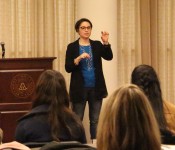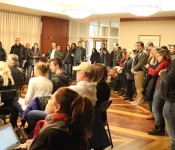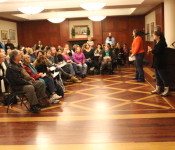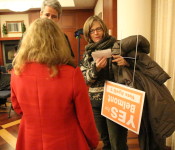Photo: Belmont Town Meeting.
As the annual legislative meeting reconvenes on Monday, June 1, at 7 p.m. at the Chenery Middle School to debate and vote on the town’s finances, the nearly 300 member will be asked to decided where to place the remainder of the $4.5 million raised after voters approved the Proposition 2 1/2 override at April’s Town Election.
With the focus of the night on the town’s operating budget, the one article that is capturing a great deal of interest is Article 12, transferring $1,674,069 of the override amount into a general stabilization fund. If approved, the funds will remain there until Town Meeting, by a two-thirds margin, approves any transfer of funds.
The key word is “if” because there is a possibility that Town Meeting might not approve the transfer of the funds in the first place. There have been rumblings by some override opponents to vote against Article 12. Since the $1.6 million would not be appropriated, that amount would not be levied in taxes in fiscal 2016, effectively providing ratepayers a small “rebate” on what they had been anticipating in taxes beginning July 1.
Warrant Committee member Adam Dash’s amendment to the fiscal 2016 budget appropriations article will be brought before Town Meeting if Article 13 fails. It would raise the $1.6 million from somewhere in the budget and place the funds into the Warrant Committee Reserve Account. The committee would sit on the amount for the entire year and allow it to become part of the town’s “free cash” amount. So at next year’s Town Meeting, those funds would be placed in the General Stabilization Fund.
“This would preserve the will of the voters by levying the full amount of override funds,” said Dash. If Article 13 passes, Dash will drop his amendment.
But before Dash’s amendment moves forward, there are a pair of amendments sponsored by former School Committee member Kevin Cunningham, on the Article 13. The two amendment would, in their way, take $250,000 of the amount and place it into the Special Education Stabilization Fund, thus providing $1,424,069 into the general fund.
According to Cunningham, the quarter million dollars being directed to the Sped Stabilization account simply replenishes the line item after it was drained by that same amount in April to help close a $500,000 deficit in this school year’s budget.
Since there is “the highest likelihood” the Sped Stabilization will be needed in fiscal ’16, Cunningham targeted fund to an area where the need will be greatest.
It doesn’t appear the amendment will find much support from the Board of Selectmen or the Warrant Committee since, as Board of Selectmen Chair Sami Baghdady said last month, “we made a promise to the voters that every dollar would be set aside for the purposes stated on the ballot” which included school deficit, capital budget bonding and streets and sidewalks.
While it doesn’t appear that Town Meeting will take up five hot-button articles – four citizen petitions and a request to reconsider the “solar” article – being brought to the assembly by newly-elected Selectman Jim Williams until the third night of the June agenda, his presence will be felt with a second amendment to Article 12 sponsored by a slew of Town Meeting members.
Dubbed by Dash as the “Warrant Committee’s summer project,” the amendment directs the Warrant Committee to produce an update report on the town’s current pension funding schedule, which targets $6 million in fiscal 2016 and increased by seven percent annually until 2027.
The Warrant Committee will take a look at different strategies to mitigate the impact the pension has on the town’s annual expenditures.
“[Williams] is the imputes for this project. And it’s something that should be done as being part of good fiscal management,” said Dash two weeks ago.





